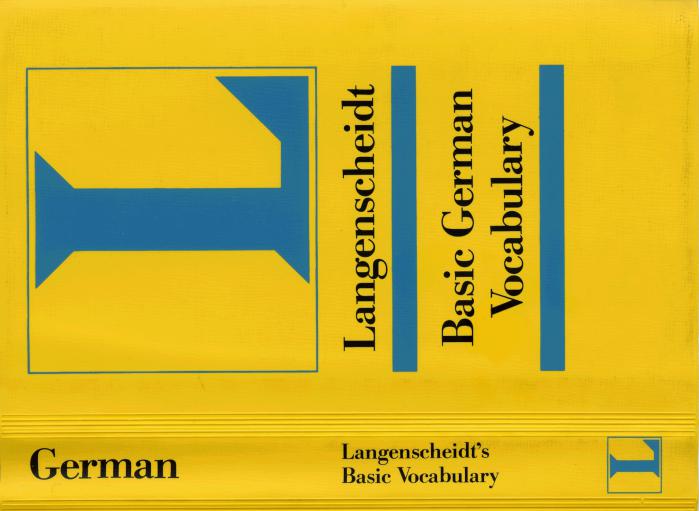
Basic_German_Vocabulary
.pdf
I. -lLLI

Abbreviations
AE |
amerikan. Englisch |
American English |
Akk. |
Akkusativ |
accusative |
Adj. |
Adjektiv |
adje ctive |
Adv. |
Adverb |
ad verb |
BE |
brit. Englisch |
British English |
dem. |
demonstrat iv |
demonstrative |
f |
fem inin |
feminin |
Gen. |
Genitiv |
genitive |
indekl. |
indeklinabel |
indeclinable |
Komp . |
Komparation |
comp arition |
Konj. |
Konjunktion |
conj unc tion |
Mod.v. |
Modalverb |
modal verb |
m |
maskulin |
masculine |
n (german co lumn) |
neutru m |
neuter |
n (engl. column) |
Nomen |
noun |
p. |
Person |
person |
PI. |
PlUral |
p lural |
Pron. |
Pronomen |
pronoun |
Präp . |
Präpos ition |
preposition |
8g. |
Singular |
singular |
v |
Verb |
verb |
V/ i. |
intransitives Verb |
intransitive verb |
V/ refl. |
reflexives Verb |
reflexi ve Verb |
V/ t. |
trans itives Verb |
transitive verb |
rzp . |
reziprok |
reciprocal |
Pronunciation see p. 419


Translation: Carol L. & Charles J. James
The spelling in Basic German Vocabulary correspond s to the Orthography Reform of 1998.
© 1991 Langenscheidt KG, Berlin and Munich
All rights reserved. No part of this material may be reproduced in any form without the perm ission of the publ ishers.
Printed in Germany . ISBN 3-468 -49 400-9
Contents
Who needs a "Basic Vocabu lary"? |
, |
VII |
Whya "Basic Vocab ulary"? . . . . . . . . . . . . . . . . . . . . . . . . . . . . . . . |
. |
VII |
Whya bilingu al "Basic Vocabulary"? |
|
VII |
Why these Words? |
|
VIII |
How is the "Basic Vocabulary" arranged? |
, |
VIII |
"Langenscheidt' sBasic German Vocabulary" and "Workbook" |
, |
IX |
How to work with the "Basic Vocabu lary"? . . . . . . . . . . . . . . . . . . . . |
. |
X |
Notes . |
|
XI |
Topical Concepts
1 |
The Human Being . . . . . . . . . . . . . . . . . . . . . . . . . . . . . . |
. |
1 |
1.1 |
The Body. . . . . . . . . . . . . . . . . . . . . . . . . . . . . . . . . . . . . . . . |
. |
1 |
1.2 |
Appearance . . . . . . . . . . . . . . . . . . . . . . . . . . . . . . . . . . . . . |
. |
5 |
1.3 |
Mind and Reason . . . . . . . . . . . . . . . . . . . . . . . . . . . . . . . . . |
. |
7 |
1,4 |
Character |
, |
12 |
1.5 |
Pleasant and Neutral Emotions |
|
15 |
1.6 |
Negative Emotions . . . . . . . . . . . . . . . . . . . . . . . . . . . . . . . . |
. |
18 |
1.7 |
Health and IIlness (See also: Doctor and Hospital 5.9) . . . .. |
, |
23 |
1.8 |
Life and Death . . . . . . . . . . . . . . . . . . . . . . . . . . . . . . . . . . . . |
. |
26 |
2 |
Actions and Activities |
|
30 |
2.1 |
The Senses and Body Funct ions . . . . . . . . . . . . . . . . . . . . . |
. |
30 |
2.2 |
Hygiene and Cleanliness |
, |
34 |
2.3 |
Doing . . . . . . . . . . . . . . . . . . . . . . . . . . . . . . . . . . . . . . . . . .. |
|
37 |
2,4 |
Movement and Rest . . . . . . . . . . . . . . . . . . . . . . . . . . . . . . . |
. |
43 |
2.5 |
Moving of Objects and Beings |
, |
49 |
2.6 |
Giving and Taking |
, |
51 |
2.7 |
Handling Objects and Beings |
, |
55 |
2.8 |
Learning and Knowledge |
|
|
|
(See also: School and Education 8,4) . . . . . . . . . . . . . . . . . . |
. |
76 |
3 |
Language and Speec h Intentions |
, |
85 |
3.1 |
General. . . . . . . . . . . . . . . . . . . . . . . . . . . . . . . . . . . . . . . . . |
. |
85 |
3.2 |
Speech. . . . . . . . . . . . . . . . . . . . . . . . . . . . . . . . . . . . . . . . .. |
|
87 |
3.3 |
Writing and Reading |
, |
91 |
3,4 |
Information |
, |
93 |
3.5 |
Expressing Opinions. . . . . . . . . . . . . . . . . . . . . . . . . . . . . . . |
. |
96 |
3.6 |
Acceptance and Reject ion . . . . . . . . . . . . . . . . . . . . . . . . . . . |
|
100 |
3.7 |
Certainity and Doubt. . . . . . . . . . . . . . . . . . . . . . . . . . . . . . . |
. |
105 |
3.8 |
Positive Evaluation and Neutrality . . . . . . . . . . . . . . . . . . . . . . |
|
112 |
3.9 |
Negative Evaluation . . . . . . . . . . . . . . . . . . . . . . . . . . . . . . . . |
|
118 |
3.10 |
Wish, Request, Order |
|
120 |
3.11 |
Courtesy Formulas, Exclamations, Conversational Fillers . . . |
|
124 |


v
9 |
Environment |
269 |
9.1 |
City,Town,Village |
269 |
9.2 |
Landseape |
271 |
9.3 |
Nature: General. |
274 |
9.4 |
Animals |
279 |
9.5 |
Plants |
283 |
9.6 |
Weather and Climate |
284 |
10 |
Teehnology and Materials |
288 |
10.1 |
Teehnology |
288 |
10.2 |
Materials |
292 |
11 |
Travel and Traffie |
296 |
11.1 |
Travel |
296 |
11.2 |
Street Traffie |
301 |
11.3 |
Vehieles |
304 |
11.4 RaH, Plane, Ship |
308 |
|
12 |
Countries and People |
311 |
12.1 |
Geographieal Names |
312 |
12.2 |
Nationalities, Inhabitants, Languages |
313 |
General Concepts |
|
|
13 |
Time |
316 |
13.1 |
Division of the Year |
316 |
13.2 TheNames of the Months |
318 |
|
13.3 |
Weekdays |
318 |
13.4 TimesofDay |
319 |
|
13.5 |
Cloek Time |
320 |
13.6 |
Other Coneepts ofTime |
321 |
13.6.1 Nouns |
321 |
|
13.6.2 Verbs |
323 |
|
13.6.3 Adjeetives |
326 |
|
13.6.4 Adverbs |
328 |
|
13.6.5 Prepositions |
333 |
|
13.5.6 Conjunetions |
334 |
|
14 |
Spatial Coneepts |
335 |
14.1 |
Nouns |
335 |
14.2 |
Adjeetives |
338 |
14.3 |
Adverbs |
340 |
14.4 |
Prepositions |
346 |

VI
15 |
Quantity and Measure |
348 |
15.1 |
Concepts of Ouantity |
348 |
15.2 |
Cardinal Numbers |
354 |
15.3 |
Measurements and Weights |
355 |
16 |
Order and Reference |
358 |
16.1 |
Order, Division |
358 |
16.2 |
Ordinal Numbers |
366 |
17 |
Ways and M ethods, Comparison |
368 |
17.1 |
Ways and Methods |
368 |
17.2 Degree, Comparison |
369 |
|
18 |
Colors |
374 |
19 |
Forms |
375 |
20 |
Cause and Effect |
377 |
21 |
Condition and Change |
381 |
Structure Words |
|
|
22 |
Pronouns |
383 |
22.1 |
Personal Pronouns |
383 |
22.2 |
Reflexive Pronouns |
382 |
22.3 PossessiveAdjectives |
387 |
|
22.4 |
Demonstrative Adjectives |
387 |
22.5 |
Ouestion Pronouns , Relative Pronouns |
388 |
22.6 |
Indefinite Pronouns |
389 |
23 |
Conjunctions |
391 |
24 |
Adverbs |
394 |
Index |
|
396 |
Pronunciation |
419 |
|

VII
Who needs a "Basic Vocabulary"?
Any stude nt learning a foreign language must master a certain vocab ulary base before he or she can communicate or read in that langu age. Acqu isition of that base voca bulary requir es study, ofte n outside of the c1assroo m setti ng.
Langenscheidt' sBasic German Vocabulary is des igned to facilit ate the acquisitio n of that core voc abulary in the easiest and most effic ient manner possible. It is meant for use by beginning learners with no previous knowledge of the German language, by more advanced students as a review and for test preparation, and by anyone as preparatio n for pleasure or business travel into a German-speaking co untry.
Those who have successfully worked through Langensch eidt 'sBasic German Vocabu lary will have the necessary know ledge to functi on and communicate in all everyday situations in German.
Whya "Basic Vocabulary"?
The German Language, like any other language, is co mp rised of millions of words, yet 50 % of normal spoke n and w ritten texts are comp rised of on ly 66 wor ds . Students rightfu lly ask, which wo rds do I have to learn in order to carry on an everyday co nversatio n or read a text written for the average German speak er?
The magic answer is usually 2,000 wor ds , i.e., a student w ho has master- ed the basic 2,000 core vocab ulary words has learned the most important words used in 80 % of all written and oral co mmunication.
Langenscheidt' s Ba" sic German Vocabul ary" contains two tim es 2,000 words .The core 2,000 words are followed bya seco nd group of the 2,000 next most frequently used words w hich comp rise a furth er 5 %-10 % of all writte n and oral communication.
The divis ion of the thematically-o rganized entries into two groups, "1- 2,000" and "2,001- 4,000", identifi es for th e learner those wor ds which should be learned immediately and those w hich can be reserved for seco nd level learning. Once they have mastered the first 2,000 wo rds, students have the option of increasing their voca bulary over a wide sub ject range, or concentrating on spec ific areas of interest , such as law, economics, etc .
Why a bilingual "Basic Vocabulary"?
The use of the target language to teach the language is the norm in most programs today. Usually a new word is explained in simp le German and illustrated with practica l examples.
The pract ical teac hing situatio n, however, requires flexibility in using th e native language, especially when difficult concepts need to be clarified .

VIII
Therefore, many monolingual textbooks have bilingual vocabulary lists or glossaries.
Because it is meant to be used indep endentl y by the learner to stud y and review outsid e class, a text like the Basic Vocabulary must be 100% bilingual. It is not meant to, and should not, replace a regular German- English/ English-German dictionary where a Iearner can find many more words and definitions, nor a comprehensive grammar text. The Basic Vocabulary is only meant to serve as a supplement for study and learning.
Why these words?
Langenscheidt 'sBasic Vocabulary selects the most important words for a student to learn and use. The Basic Vocabulary is based on evaluation of numerous lists of basic German vocab ulary published in Germany, Austria, Swit zerland and other countries .All the important sources of information on word frequency in written and spoke n German were considered. An exact source list would go beyond the purpose of this introduction . For those interested, we mention here the vocabulary statistics of Kaeding, Meier, Ortm ann, the Mannheimer Korpus 1 and 2, the Bonner Zeitungskorpus and the minimum vocabulary lists prepared by the Council of Europe, vocabulary for the "Zertifikat Deutsch als Fremdsprache" (Certifi- cate of German as a Foreign Language), the "Deutscher Volkshochschulverband" (German Adult Education Association) and the Goethe Institute. The choice of words was not based only on frequency. Factors such as how familiar and useful a word is in everyday conversation were also considered. Langenscheidt's experience in producing dictionaries and teaching materials also helped. The critical choice of example sentences was made by native speakers on an outside of our regular staff.
How is the "Basic Voca6ulary" arranged?
Words and expressions in Langenscheidt' sBasic Vocabulary German are arranged by topic, not simply in alphabetical order. Educational research indicates that trying to learn words alphabetically is not effective. Similari- ties in orthography lead to confusion and spelling errors. Most impor- tantly, words are very difficult to learn without context and top ic. Alphabe- tical arrangement can become an obstacle to corre ct use in a specific thematic situation. Learning basic words in subject areas is easier and more effective. The conte xtual relationships among word s and the physi- cal proximity of words on the page encourage the development of associat ions in memory. For all these reasons, we emphasize learning in subjec t areas.
